

Vol. 40 (Number 4) Year 2019. Page 8
Nurfatwa Andriani YASIN 1; Syamsul RIDJAL 2; Muh JUFRI 3; ANSHARI 4
Received: 28/08/2018 • Approved: 24/01/2019 • Published 04/02/2019
ABSTRACT: This research is one of the efforts to improve the productivity of traditional craftsmen in Bone Regency South Sulawesi Province considering the handicrafts industry in Bone Regency is experiencing growth in the number of business units and workers. From 2010 to 2017, there was a decrease in the number of business units, which affected the number of workers in those units. The decrease ranged between 19%-29%. This research investigates and measures human capital and entrepreneurship aspect of craftsmen in increasing their productivity. Furthermore, it is expected that a solution to various problems experienced by the traditional handicrafts industry in Bone Regency South Sulawesi Province found. This research employed quantitative method by using Structural Equation Modelling (SEM) that reveals the correlation and effect, either direct or indirect between endogenous and exogenous variables. The result of the analysis shows that Human Capital has direct effect on productivity, and Human Capital has indirect effect on productivity through entrepreneurship. For craftsmen, they should have the courage to change their mind set and habits that are monotonous in order to be able to improve all the elements of creativity in their entrepreneurial spirit related to their craftsmanship for the sake of the continuity of this kind of SME. |
RESUMEN: Esta investigación presenta los esfuerzos para mejorar la productividad de los artesanos tradicionales en la provincia de Sulawesi del sur de Bone Regency (Indonesia) considerando que esta industria está experimentando un crecimiento en número de unidades de negocios y de trabajadores. De 2010 a 2017, hubo una disminución en el número de unidades de negocios, lo que afectó el número de trabajadores en esas unidades. La disminución osciló entre 19% -29%. Esta investigación investiga y mide el aspecto del capital humano y el espíritu empresarial de los artesanos para aumentar su productividad. Además, se espera que se encuentre una solución a varios problemas experimentados por la industria de artesanías tradicionales en la provincia de Sulawesi del Sur de Regency Bones. Esta investigación empleó un método cuantitativo mediante el uso de modelos de ecuación estructural (SEM) que revela la correlación y el efecto, ya sea directo o indirecto entre variables endógenas y exógenas. El resultado del análisis muestra que el capital humano tiene un efecto directo en la productividad, y el capital humano tiene un efecto indirecto en la productividad a través del espíritu empresarial. Para los artesanos, deben tener el coraje de cambiar su mentalidad y sus hábitos que son monótonos para poder mejorar todos los elementos de la creatividad en su espíritu empresarial relacionado con su artesanía en aras de la continuidad de este tipo de PYME. |
In the development of economic history, the attention of governments in most countries in the world initially more focused on large scale businesses, or at least on medium scale businesses. However, in subsequent developments, there had been quite dynamic changes in orientation as governments began to notice and acknowledge the existence of small scale businesses. The government's attention to small scale business has shown a consistent attitude towards the urgency of this sector in the Indonesian economic system.
Small businesses in their development often face various obstacles. These are generally related to some aspects such as capital, licensing, investment opportunities, business opportunities, marketing, product quality and lack of management skills, experience and technology used.
In the handicrafts industry in Bone Regency from 2010 to 2017, there was a decrease in the number of business units, which affected the number of workers in those units. The decrease ranged between 19%-29%.
A phenomenon interesting to be observed is the educational qualifications of the craftsmen. This aspect is very closely related to one of the variables analysed in this research, human capital, and another factor is the lack of entrepreneurial spirit owned by the craftsmen.
It is argued that the development of the education sector with human resources as the main focus has contributed directly to the economic growth of a country, through the improvement of the skills and production capabilities of workers (Schultz, 1961). In this case, human capital is a long-term investment in the development of human resources to increase productivity (Becker, 1994). Human capital is the existing knowledge that lies within human resources, which is the basis for productivity improvement. In addition to human capital, entrepreneurial spirit also plays a very important role for craftsmen. Entrepreneurs are people who organize, manage and have the courage to take risks in order to start a new business and create opportunities (Steinhoff & Burgess, 1993). Entrepreneurs should be able to look forward to the future more optimistically. In this case, they are able to look ahead by thinking and taking advantage of opportunities with full calculation. Since having a long-term view of the future, they will always try to keep on working (Suryana & Bayu, 2010). The key is the ability to create something new and different from the existing one. Despite the possible risks, this kind of person must remain steadfast in looking for opportunities. That is why these two factors play an important role in improving the productivity of craftsmen.
What is the effect of human capital on the productivity of the craftsmen?
What is the effect of human capital on the productivity through the entrepreneurial spirit of the craftsmen?
Analysing and assessing the effect of human capital on the productivity of the craftsmen.
Analysing and assessing the effect of human capital on the productivity through the entrepreneurial spirit of the craftsmen.
The competitive effectiveness of a company lies in the managerial ability to develop, provide, and integrate individuals collectively in order to gain specialized knowledge in producing skills, innovations and abilities that will in turn lead to improved performance (Rastogi, 2000). In addition, Andrew Mayo (2001) argues that maximizing human capital through acquisition, retention, growth should be a top priority of all executives in an organization because employees are one of the important factors that encourage the performance and productivity of all other employees (Mayo, 2001). In addition, a healthy organization is a healthy organization financially, healthy in business and has a good human capital competence (Ruslan, Musa, & Parawansa, 2017).
It is studied the extent to which investment in human capital and social capital, in addition to the "talent" effect, can enhance entrepreneurial performance (Bosma, Van Praag, Thurik, & De Wit, 2004). The results reveal that human and social capital investment can improve entrepreneurial performance substantially. In his research suggests that Human capital - including education, experience, knowledge, and skills affect success, and the results of his research indicate a positive correlation between human capital and success (Unger, Rauch, Frese, & Rosenbusch, 2011).
The competitive effectiveness of a company lies in the managerial ability to develop, provide, and integrate individuals collectively in order to gain specialized knowledge in producing skills, innovations and abilities that will in turn lead to improved performance (Rastogi, 2000). In addition, Andrew Mayo, 2001 argues that maximizing human capital through acquisition, retention, growth should be a top priority of all executives in an organization because employees are one of the important factors that encourage the performance and productivity of all other employees (Mayo, 2001). In addition, a healthy organization is a healthy organization financially, healthy in business and has a good human capital competence (Ruslan, Musa, & Parawansa, 2017).
It is studied the extent to which investment in human capital and social capital, in addition to the "talent" effect, can enhance entrepreneurial performance (Bosma, Van Praag, Thurik, & De Wit, 2004). The results reveal that human and social capital investment can improve entrepreneurial performance substantially. In his research suggests that Human capital - including education, experience, knowledge, and skills affect success, and the results of his research indicate a positive correlation between human capital and success (Unger, Rauch, Frese, & Rosenbusch, 2011).
The terms of “entrepreneur” and “self-employed” are often used interchangeably, although they have somewhat different substances. Conceptually, entrepreneur is often termed as a skilled person in exploiting opportunities to develop his business with the aim to improve the quality of his life. In essence, everyone is an entrepreneur in the sense that they are capable of being self-sufficient in running their business in order to achieve their personal, family, and community goals, and even national goals, but many of us do not strive to achieve better performance for the future, and become dependent to others, other groups and even other nations. It is proposed the definition of entrepreneur as follows (Scarborough & Zimmerer, 1996).
An entrepreneur is one who creates a new business in the face of risk and uncertainty for the purpose of achieving profit and growth by identifying opportunities and assembling the necessary resources to capitalize on those opportunities.”
Entrepreneurs are people who organize, manage and have the courage to take risks in order to start a new business and create opportunities (Steinhoff & Burgess, 1993) . An entrepreneur should be able to look forward to the future more optimistically. In this case, they are able to look ahead by thinking and trying, as well as by taking full advantage of opportunities. Future-oriented people are those with perspectives and views of the future
Entrepreneurs who have achievement motivation in general have the following characteristics (Suryana & Bayu, 2010).
The definition of entrepreneur is actually attached to its characteristics. In this case, entrepreneur refers to everyone who is good at creating opportunities. The opportunities are created through value addition to goods or services by applying those characteristics.
Any organization either in the form of company or non-profit organization will always strive for the members or workers involved in the activities of the organization have a good performance in the form of a high level of productivity to realize established goals.
Productivity is important especially in companies because the increase of company productivity means the increase of company competitiveness. It is argued that:
"Classical theory explains that productivity is measured by the number of products, services, and processes produced by a company divided by utilization and use of factors of production including land (L), labour (L) and capital (C). So far, productivity is believed to be an important aspect of competitiveness because it is an indicator of efficiency, and if a company operates inefficiently, it is guaranteed that it will be difficult to maintain its productivity and competitiveness" (Zuhal, 2010)
The productivity is a comparison between the results achieved (output) with the total resources (input) used per unit time (Simanjuntak, 2000). Resources can be land, raw materials, machinery, and labour. While the results achieved can be the amount of output produced and the value of output (in the form of currency units). When output is compared to all the resources used for production activities, the result is called total productivity. On the other hand, if only one resource is used for production activities, the result is called partial productivity, such as the productivity of land, materials, machinery, or labor.
Based on the above statement, it can be concluded that productivity is a mental attitude of workers to always strive more than what has been and is being attempted to accelerate the achievement of goals.
Figure 1
Conceptual Framework
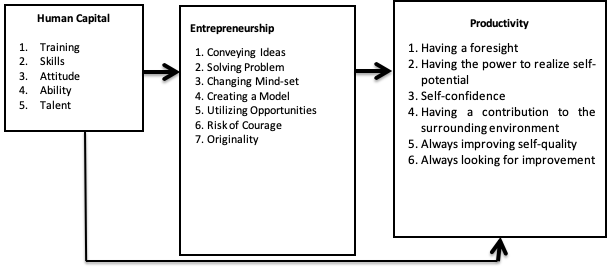
The research was conducted in Bone Regency Sulawesi Selatan involving 143 culture-based craftsmen. Quantitative data were analysed using descriptive analysis and Structural Equation Modelling (SEM). In the analysis according to Ghozali (2006), the path analysis model of all latent variables in Partial least square (PLS) consists of three sets of relationships. A first, inner model specifies relationships between latent variables (structural models). Second, outer model specifies relationships between latent variables and the measurement model. Third, weight relation is where the case value of latent variables can be estimated.



There are two hypotheses presented in this study. The first hypothesis is “human capital has a significant effect on the productivity of craftsmen”. The second hypothesis is “there is an indirect influence between human capital and productivity through entrepreneurship”.
Figure 2
The first Partial Least Squares Model for the Hypothesis 1
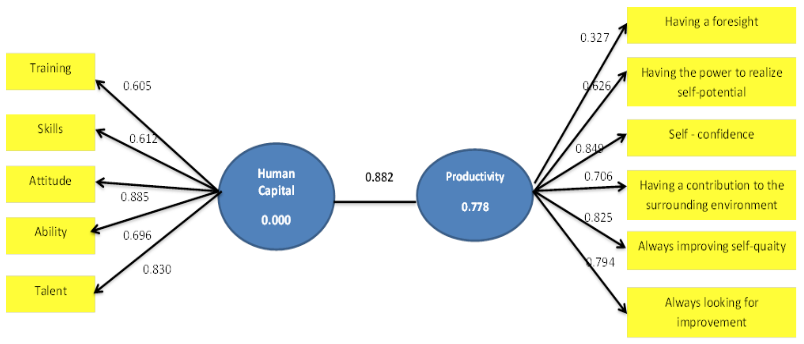
The Smart PLS output illustrated in Figure 1 shows the presence of an indicator that has a factor loading below 0.5, which is having a foresight (HF). According to Ghozali (2008) these indicators should be dropped from the model because they have low convergent validity. The model is rerun by omitting having a foresight (HF) and the result is presented in Figure 2 below.
Figure 3
The second Partial Least Squares Model for the Hypothesis 1
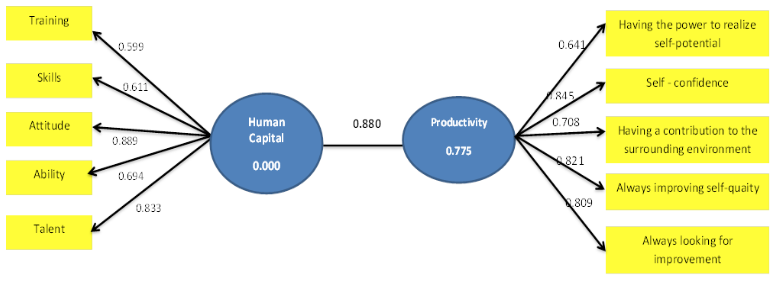
In Figure 2, the model already meets the convergent validity requirement since there are no more factors loading below 0.5, meaning that the model is ready to be analysed.
Human capital and productivity constructs are analysed by looking at the convergent validity and reliability of each indicator. The output in Table 1 and Figure 2 shows that after dropping the variable of having a foresight (HF), the factor loadings for both constructs are above the required 0.5, with a T-statistics above 1.96 (for a significance level of 0.05). This indicates that the constructs have good discriminant validity.
Table 1
Outer Loadings (Mean, STDEV, T-Value)
|
Original Sample (O) |
Sample Mean (M) |
Standard Deviation (STDEV) |
Standard Error (STERR) |
T Statistics (|O/STERR|) |
Training <- Human Capital |
0.599336 |
0.599908 |
0.051319 |
0.051319 |
11.678681 |
Skills <- Human Capital |
0.611342 |
0.611833 |
0.043627 |
0.043627 |
14.012780 |
Attitude <- Human Capital |
0.888822 |
0.890111 |
0.012974 |
0.012974 |
68.508464 |
Ability <- Human Capital |
0.694452 |
0.690245 |
0.038008 |
0.038008 |
18.270981 |
Talent<- Human Capital |
0.833483 |
0.834257 |
0.015421 |
0.015421 |
54.047118 |
Having a power to realize self-potential <- Productivity |
0.641313 |
0.640943 |
0.045152 |
0.045152 |
14.203438 |
Self-confidence<- Productivity |
0.853821 |
0.857274 |
0.019196 |
0.019196 |
44.479236 |
Having a contribution to surrounding environment<- Productivity |
0.708317 |
0.706356 |
0.035651 |
0.035651 |
19.868067 |
Always improving self-quality <- Productivity |
0.821326 |
0.821279 |
0.016872 |
0.016872 |
48.679192 |
Always looking for improvement <- Productivity |
0.808777 |
0.806687 |
0.026771 |
0.026771 |
30.210594 |
Source: Data Analysis from Smart PLS (2017)
PLS output indicates that there are some indicators that have a factor loading below 0.5 namely MG (conveying ideas), BTR (courage to take risk), and MPD (visionary). These indicators are dropped because they have low convergent validity. The model is rerun by omitting those indicators and the result is shown below.
Table 2
R-Square and Cronbachs Alpha
|
R Square |
Human CapitalProductivity |
0.775107 |
-----
Table 3
Path Coefficients (Mean, STDEV, T-Values)
|
Original Sample (O) |
Sample Mean (M) |
Standard Deviation (STDEV) |
Standard Error (STERR) |
T Statistics (|O/STERR|) |
Human Capital -> Productivity |
0.80402 |
0.882409 |
0.010344 |
0.010344 |
85.108309 |
Source: Data Analysis from Smart PLS (2017)
From table 3 above, it can be seen that the coefficient parameter between human capital and productivity is 0.8804, indicating that there is a positive correlation between human capital and productivity.
Figure 4
The First Partial Least Square Model for the Second Hypothesis
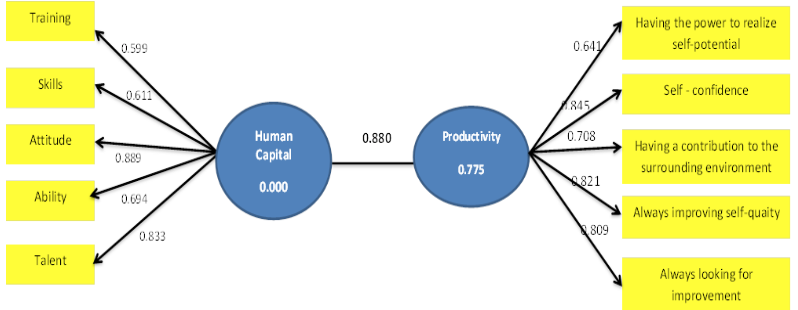
PLS output indicates that there are some indicators that have a factor loading below 0.5 namely MG (conveying ideas), BTR (courage to take risk), and MPD (visionary). These indicators are dropped because they have low convergent validity. The model is rerun by omitting those indicators and the result is shown below.
Figure 5
The second Partial Least Square Model for the Second Hypothesis
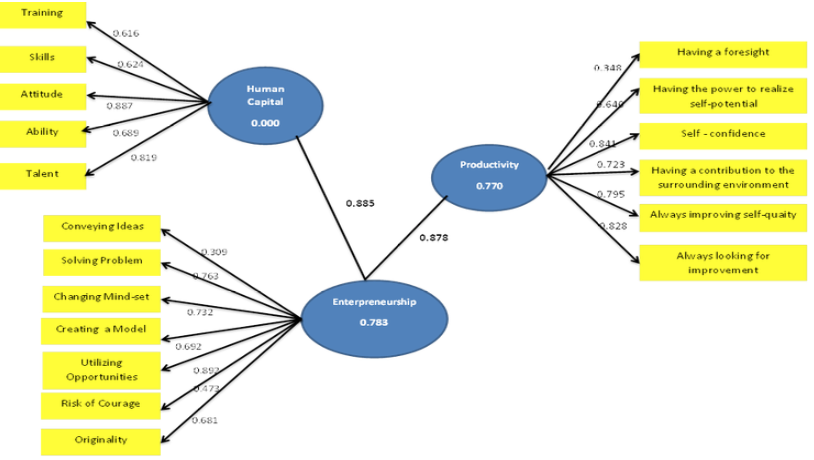
In figure 4, the model already meets the convergent validity requirement because there are no more factor loadings below 0.5 so that the model is ready to be analysed.
Table 4
Outer Loading (Mean, STDEV, T-Values)
|
Original Sample (O) |
Sample Mean (M) |
Standard Deviation (STDEV) |
Standard Error (STERR) |
T Statistics (|O/STERR|) |
Training <- Human Capital |
0.609081 |
0.608402 |
0.046779 |
0.046779 |
13.020407 |
Skills<- Human Capital |
0.620724 |
0.619738 |
0.042178 |
0.042178 |
14.716878 |
Attitude<- Human Capital |
0.890852 |
0.890461 |
0.011445 |
0.011445 |
77.836234 |
Ability <- Human Capital |
0.684364 |
0.684569 |
0.036572 |
0.036572 |
18.712563 |
Talent <- Human Capital |
0.823721 |
0.825494 |
0.018826 |
0.018826 |
43.753894 |
Solving problem<- Entrepreneurship |
0.788731 |
0.788330 |
0.025478 |
0.025478 |
30.957659 |
Changing mindset <- Entrepreneurship |
0.751963 |
0.753224 |
0.034345 |
0.034345 |
21.894528 |
Creating a model <- Entrepreneurship |
0.901568 |
0.902345 |
0.007608 |
0.007608 |
118.498099 |
Utilizing opportunity <- Entrepreneurship |
0.901568 |
0.902345 |
0.007608 |
0.007608 |
118.498099 |
Originality <- Entrepreneurship |
0.649131 |
0.647625 |
0.034970 |
0.034970 |
18.562540 |
Having a power to realize self-potential <- Productivity |
0.658161 |
0.654028 |
0.043384 |
0.043384 |
15.170663 |
Self-confidence<- Productivity |
0.839655 |
0.840889 |
0.019370 |
0.019370 |
43.348782 |
Having a contribution to surrounding environment <- Productivity |
0.720499 |
0.724663 |
0.035099 |
0.035099 |
20.527468 |
Always improving self-quality <- Productivity |
0.789590 |
0.791354 |
0.020378 |
0.020378 |
38.748006 |
Always looking for improvement <- Productivity |
0.839478 |
0.839154 |
0.017244 |
0.017244 |
48.682485 |
The output shows that the factor loading of the constructs is above the required 0.6, with a T-value above 1.96 (for a significance level of 0.05). This indicates that the constructs have good discriminant validity.
Table 5
Path Coefficients (Mean, STDEV, T-Value)
|
Original Sample (O) |
Sample Mean (M) |
Standard Deviation (STDEV) |
Standard Error (STERR) |
T Statistics (|O/STERR|) |
Human Capital -> Entrepreneurship |
0.879473 |
0.880437 |
0.008098 |
0.008098 |
108.601540 |
Entrepreneurship-> Productivity |
0.902783 |
0.903412 |
0.010377 |
0.010377 |
86.995326 |
Partially, human capital has significant effect on productivity. This condition can be interpreted that the craftsmen in handicrafts industry who possess good human capital condition, for example, having knowledge gained from non-formal education, skill, praiseworthy work attitude, high level of competence and talent, will increase productivity which is an invaluable asset for the progress of their business. The results of this research are in line with the empirical study conducted by (Mayo, 2001) that the driving factor of this economic value is human capital with all the knowledge, ideas, creativity and innovation it has that increase the productivity of a company. This is relevant to some theories and research as conducted by (Schermerhon, 2005) revealing that human capital is also the core of a business because it has the economic value of human resources in terms of ability, knowledge, creative ideas, innovation, energy and commitment.
The results of this study explain that human capital can increase the value of productivity which is also determined by the factors of knowledge and competence of craftsmen. Increasing the productivity of craftsmen in this craft is driven by a large part of the craftsmen's efforts to improve their skills, attitudes and ability to always grow and develop in producing crafts.
The training and skills that are often held by Bone Government are aimed at changing behaviour and increasing the capabilities of the craftsmen. Changes in the desired behaviour of craftsmen are certainly related to the increase in skills, attitudes, knowledge, behaviour, and others that can affect work productivity. So far, only a small number of craftsmen have had the awareness to want to take part in the training held by Bone Government. This is not only an obstacle for abilities of Bone government but also to increase the business spirit of the craftsmen. Therefore, the craftsmen cannot only make or produce but also be able to exit in the market.
In general, human capital of craftsmen is able to grow productivity well. It only needs guidance and empowerment direction from Bone government as a whole. The government should foster human resource development and technological capacity building. Human resource development is in the form of design training and entrepreneurial motivation. However, the development has not been carried out thoroughly for craftsmen. The development of technological capabilities in the form of technological capabilities in this way provides knowledge to craftsmen on how to market their products by using technological assistance, for example by using the world of social communication such as Facebook, Instagram, and even internet markets such as Bukalapak and Tokopedia. This really helps craftsmen to gain market share nationally if they are serious about this method.
The results of this research indicate a strong correlation between human capital and productivity through entrepreneurial spirit. Referring to the theory, it implies that if the craftsmen have human capital and entrepreneurial spirit, their productivity will increase and organizational goals will be achieved. Thus, productivity and human capital are synergistic constructs.
Based on data analysis, it was found that the indirect effect of the Human Capital variable on productivity through entrepreneurial creativity has a higher coefficient of value compared to the coefficient value of the direct effect of the variables of Human Capital on productivity.
The results of this study illustrate that if the productivity of the craftsmen wants to be improved, the first thing to do is to try to develop the spirit of entrepreneurial creativity. This influence can be interpreted that if the craftsmen of Songkok Recca craft industry have good human capital, for example, accompanied by knowledge, skills, work attitudes that are commendable, have high competence and talent, then the craftsmen will continue to orient themselves to entrepreneurship that can compete and consistently pursue handicraft business that is occupied. Thus, the productivity of craftsmen will increase by itself.
The results of this research showing the effect of human capital on productivity through entrepreneurship are in line with an empirical study conducted by (Cowling, 2003) on entrepreneurs, which revealed that human capital entrepreneur has a positive correlation and positive and significant role to the productivity of workers. It is in line with the finding of (Aisyah, Musa, & Ramli, 2017). It is stated that high entrepreneurship orientation in the same direction will have a significant impact on increasing the competence of entrepreneurs and impact on improving business performance.
Human capital and productivity have a positive correlation, as productivity is highly dependent on human capital possessed by the craftsmen. This research reveals that productivity is also determined by various factors such as education, skills, discipline, work attitude and ethic, motivation, work environment, technology, and various government policies. The high correlation between human capital and productivity through entrepreneurship is due to the entrepreneurial creativity currently owned by the craftsmen that is no longer constrained by some cultural barriers that make it difficult to unleash creativity, which encourages them to increase their productivity. If these craftsmen have human capital and entrepreneurial spirit, their productivity will increase and their organizational goals will be achieved.
Aisyah, S., Musa, C. I., & Ramli, A. (2017). Effect of Characteristics and Entrepreneurial Orientation towards Entrepreneurship Competence and Crafts and Arts SMEs Business Performance in Makassar. International Review of Management and Marketing, 7(2), 166–173.
Becker, G. S. (1994). Human capital revisited. In Human Capital: A Theoretical and Empirical Analysis with Special Reference to Education (3rd Edition) (pp. 15–28). The university of Chicago press.
Bosma, N., Van Praag, M., Thurik, R., & De Wit, G. (2004). The value of human and social capital investments for the business performance of startups. Small Business Economics, 23(3), 227–236.
Cowling, M. (2003). Productivity and corporate governance in smaller firms. Small Business Economics, 20(4), 335–344.
Ghozali, I. (2008). Structural equation modelling: Alternative method with partial least square (pls). Badan Penerbit Universitas Diponegoro.
Gratton, L., & Ghoshal, S. (2003). Managing Personal Human Capital:: New Ethos for the ‘Volunteer’Employee. European Management Journal, 21(1), 1–10.
Mayo, A. (2001). Human Value of the Enterprise. Nicholas Brealey Publishing London.
Rastogi, P. N. (2000). Sustaining enterprise competitiveness–is human capital the answer? Human Systems Management, 19(3), 193–203.
Ruslan, M., Musa, C. I., & Parawansa, D. A. (2017). The Influence of Healthy Financial, Business, and Human Resource Competence toward the Performance of Cooperation Institution: A Study on the People Living in the Coastal Area in Makassar. International Review of Management and Marketing, 7(2), 221–225.
Scarborough, N. M., & Zimmerer, T. W. (1996). Effective Small Business Management [Video]: Entrepreneurship and New Venture Creation. Prentice Hall.
Schermerhon. (2005). Management, 8th edition. USA: John Wiley & Sons, Inc.
Schultz, T. W. (1961). Investment in human capital. The American Economic Review, 51(1), 1–17.
Simanjuntak, P. (2000). Tenaga Kerja, Produktivitas dan Kecenderungannya dalam Produktivitas dan Tenaga Kerja Indonesia; Kumpulan kertas kerja, J. Ravianto Putra. Jakarta: LSIUP.
Steinhoff, D., & Burgess, J. F. (1993). Small Business Management Fundamentals. McGrawhill Inc. New York.
Stockley, T. Derek, Paul. 2003. Human Capital Concept, Definition and Explanation. www.derekstockley-05/018-Human Capital.html. (n.d.).
Suryana, Y., & Bayu, K. (2010). Kewirausahaan. Pendekatan Karakteristik Wirausa Hawan Sukses, Kencana Prenada Media Group, Jakarta.
Unger, J. M., Rauch, A., Frese, M., & Rosenbusch, N. (2011). Human capital and entrepreneurial success: A meta-analytical review. Journal of Business Venturing, 26(3), 341–358.
Weatherly, L. A. (2003). The value of people. HR Magazine, 48(9), 1–10.
Zuhal. (2010). Knowledge Flatform, Kekuatan Daya Saing dan Inovation. Jakarta: Pustaka utama dan Kompas Gramedia.
1. Lecturer, Economics Department, Universitas Teknologi Sulawesi, Indonesia. Contact e-mail: nurfatwa.economics@gmail.com
2. Professor, Universitas Negeri Makassar, Indonesia.
3. Professor, Universitas Negeri Makassar, Indonesia.
4. Professor, Universitas Negeri Makassar, Indonesia.